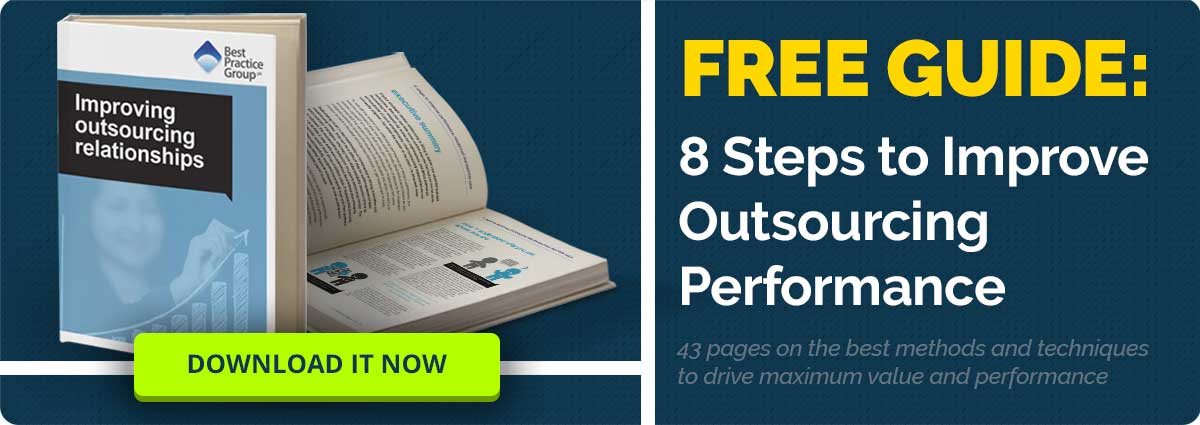
In our recent blog ‘Roadmap to More Successful Strategic Outsourcing Relationships’, we discussed a top-level view of the steps any organisation should take to improve their chances of project success when working with outsourced partners, then pointed to our white paper on the subject for a great deal more detail. With this overview in mind, to improve partnership performance, it is now important to focus on one very important aspect of strategic relationship management – living up to your responsibilities.
The Obvious and Not So Obvious Duties
No matter whether you are a strategic partner/vendor or a client, when you look beyond the obvious responsibilities that you agree to in your written contracts, there are still more duties that you owe to the project and to one another, that are a little less tangible, and less often considered in the detail they deserve. Some of them have legal implications, others have the power to change the fortunes of a project, but all should be addressed.
Do You Need to Shape or Reshape to Improve your Strategic Partnership Relationship?
If you are currently working with one or more strategic partners/vendors and the project, or the relationship that supports it, has started to go astray, or if you are about to begin a procurement phase, this article may offer some useful insights into how to shape, or reshape, your working relationships. While often easier to blame the ‘other side’ when things go wrong, experience tells us that it can often be one’s own actions or inaction that creates or contributes to the situation you find yourself in. Because of this, it is important that you know not only what everyone else’s responsibilities are, but also your own, and to do your utmost to discharge these duties to the best of your ability for the good of the project.
Strategic Partner’s Responsibilities
On major outsourced projects, partners are often selected for their expert knowledge. It’s this expert knowledge and the advice that they impart that’s at the heart of a partner’s/vendor’s responsibilities to their client.
In no particular order:
Duty No. 1: Determine, with clarity, whether the proposed solution is ‘fit for purpose’
If you represent a strategic partner/vendor, you have a responsibility to exercise all due diligence in determining what the best solution for a client would be and clearly communicating this to them. But more than that, it is also your responsibility to determine whether there are weaknesses in the client’s brief or in your ability to service their needs. This responsibility does not end after the procurement stage, as you are responsible for informing the client if and when anything that could impact on your ability to perform your duties or deliver on their objectives comes to light.
Duty No. 2: Validate that all appropriate resources are available to service the project
A strategic partner/vendor’s ability to deliver on their promises is influenced by three primary factors – the right solution, the right budget, and the right resources. If you negotiate an appropriate fee and expertly determine the solution most likely to achieve your client’s objectives, the project can still go awry if you do not have the resources at hand to service the solution. Resources here could mean anything from specialist skills and knowledge to manpower and technology. It is your responsibility as project partners to inform your client if you are lacking any of these resources, and to offer a solution for bridging that gap.
Duty No. 3: Provide evidence of reasoning and capability behind the choice of solution
The use of a sales team may be considered to be the most effective form of winning new clients, but often they lack the expertise that those in the operations and technical departments can offer. From past experience, we’ve seen instances where sales teams have over-promised, leaving operational and technical personnel in a difficult situation where they can only under-deliver. A sales force that provides a blend of skills from all three teams could be more effective as it would be able to answer more functional questions that arise at the outset, offering practical solutions where standard offerings will not suffice, and they can more quickly validate the suitability of selected solutions. But, as responsible strategic partners/vendors, you must also be prepared to offer reasoning to a client – being able to explain why you have selected the solution you have for them and why you have suggested specific choices. Some clients may ask for this, but all should be given a clear appreciation of the reasoning behind your advice and guidance.
Duty No. 4: Live up to your representational and expert advice responsibilities
When you guide your potential client in your initial meetings, what you promise and what you advise them to do will inform their decision as to whether they should choose you for their project. Quite appropriately, therefore, all of these discussions come under the heading of ‘expert advice’ and, no matter whether they are in your written contract or not, you can be held accountable for things you say in such discussions should things not go as planned and legal action ensues. Some vendors will attempt to ‘contract out’ of these responsibilities by adapting clauses into their agreements with clients. But experience tells us that courts will take a very dim view of this. You have a responsibility to back up your representations with action.
Client’s Responsibilities
As the instigator of a project it can be tempting to believe that your responsibilities end the moment you select an appropriate vendor to shoulder the burden of carrying the project forward. Surely now is the time to divert resources elsewhere and leave them to it? We would suggest otherwise, because while it is inadvisable to be too involved in how your vendor delivers on your expectations it is vitally important to give them every opportunity to do so. This is only possible if you commit to the following responsibilities.
In no particular order:
Duty No. 1: To present a clear, detailed and accurate account of your needs
In our previous article we went into some detail on this subject: the need for a detailed analysis of where you currently stand, where you wish to end up after the project and a calculable, definable difference between the two. The quantification of benefits achievable as a result of the project, and a clear business case for pursuing this goal with costs stacked against rewards, needs to be identified and built into an unambiguous vision for the project that can be clearly communicated to the vendor. Any lack of clarity, or shortcomings in the development of the business case, could result in ambiguous instructions and, as a result, a parting of understanding and expectation that could set a project off in the wrong direction.
Duty #2: Check that your strategic partner understands these needs completely
It is your responsibility to ensure that even the clearest of communications between you and your partner are not misunderstood. No matter how fastidiously you produce communications you can never make them one hundred per cent ‘misinterpretation-proof’, so do not assume that yours will be. If you have ever been in a strategic partnership that has deviated from its course, become lacklustre or failed entirely, the source of the problem could well be traced back to a misunderstanding of your needs, whether small or pivotal, somewhere down the line. Check and check again, meet with your counterparts and discuss their understanding of your requirements in detail, do not let the project progress until you are certain that they ‘get it’, that they understand with crystal clarity what your expectations are of them.
Duty No 3: Do your utmost to work collaboratively with your strategic partners
When you work with a strategic partner you are working with the emotions, politics, aspirations and work ethics of all those they allocate to your project. So alongside a holistic understanding of your vendor as an entity, you need to also understand what makes the individuals that work for them tick. To do this in the most effective way possible it is important to form an Intelligent Client Function (ICF) team – a group of, among other things, strategic partner/vendor relationship management specialists. This team should be created at the very outset and be involved in the project from inception to implementation. They are the consistent face of your organisation for your vendors and for you they are a valuable resource for understanding how best to work collaboratively with your partners – to improve working practices, to develop innovation-encouraging environments, to motivate higher productivity, and to be an early warning system should issues begin to appear.
Duty No. 4: Work with your strategic partners to resolve any and all challenges faced along the way
Should challenges arise – and they will – you may find yourself pointing the finger and saying ‘you caused it, now you solve it’. Commonplace though it may be to believe that everything that goes wrong must be the strategic partner’s fault, there can be instigating factors on your side that you may be unaware of. Therefore, the final of our four primary responsibilities that the client must live up to is a commitment to work together with vendors to rapidly and effectively fix anything that goes wrong on the project and in your relationship. Together you can get things back on track far faster and, if a strategic relationship starts to deteriorate, remember it’s almost always far more cost-effective for the project for you to come to an amicable solution rather than exit from your relationship, which will no doubt be a costly and painful experience.
Improve Strategic Partnership Performance
Collaboration is the magic word here, harmoniously working together towards a common goal. While such utopian aspirations may be far from realistic in many real-world strategic outsourcing relationships, remembering your responsibilities and doing your bit to ensure that they are discharged to the best of your ability is one way of influencing a positive outcome for a project. And, if the worst comes to the worst and your project does not achieve its outcomes, and this results in it descending into legal action, by your efforts you will have gone some way to bolstering your legal position in the eyes of the court. In the worst case scenario, and long before this happens, both sides should hopefully have done all they can to rebuild trust by leading by example, by acknowledging their duties to the other side and the project and by showing commitment to fulfilling them.
If you would like to find out more about a collaborative approach to partnership responsibilities, you can read our eBook on the subject.


